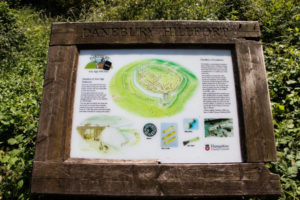The Rollright Stones is a complex of three Neolithic and Bronze Age megalithic monuments near the village of Long Compton, on the borders of Oxfordshire and Warwickshire. Constructed from local oolitic limestone, the three monuments now known as the King’s Men and the Whispering Knights in Oxfordshire and The King Stone in Warwickshire, are distinct in their design and purpose, and were built at different periods in late prehistory. The stretch of time during which the three monuments were erected bears witness to a continuous tradition of ritual behavior on sacred ground, from the 4th to the 2nd millennium BCE.
The first to be constructed was the Whispering Knights, a dolmen that dates to the Early or Middle Neolithic period. This was followed by the King’s Men, a stone circle which was constructed in the Late Neolithic or Early Bronze Age; unusually, it has parallels to other circles located further north, in the Lake District, implying a trade-based or ritual connection. The third monument, The King Stone, is a single monolith, and although it is not known when it was constructed.







